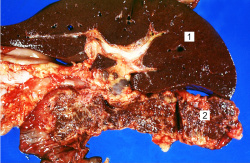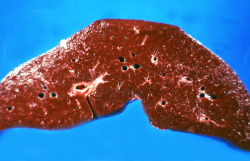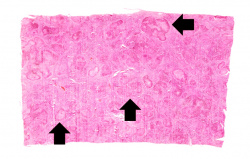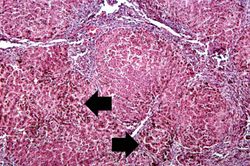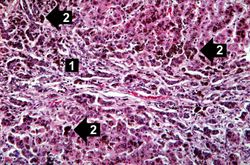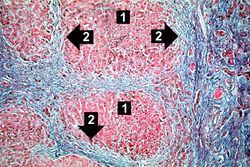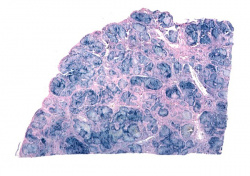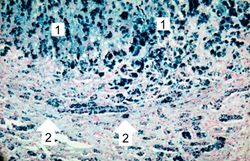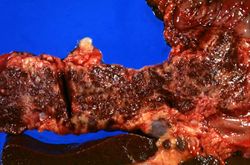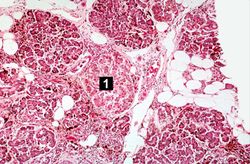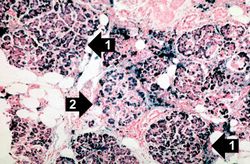Difference between revisions of "IPLab:Lab 5:Hemochromatosis"
(→Autopsy Findings) |
(→Images) |
||
| Line 6: | Line 6: | ||
== Images == | == Images == | ||
<gallery heights="250px" widths="250px"> | <gallery heights="250px" widths="250px"> | ||
| − | File: | + | File:IPLab5Hemochromatosis1b.jpg|This is a gross photograph of liver (1) and pancreas (2) from this case of hemochromatosis. Note that both of these organs have a dark brown coloration. |
| − | File: | + | File:IPLab5Hemochromatosis2b.jpg|This is a gross photograph of a cut section of liver from this case of hemochromatosis. Note that the liver is dark brown. Although hard to appreciate in a photograph, the tissue is also firm (cirrhotic). |
| − | File: | + | File:IPLab5Hemochromatosis3b.jpg|This is a low-power micrograph of liver from this patient. Note the nodularity of the tissue (arrows). |
File:IPLab5Hemochromatosis4.jpg|This higher-power view of liver from this case demonstrates the nodules and the brown/black pigment within liver parenchymal cells (arrows). | File:IPLab5Hemochromatosis4.jpg|This higher-power view of liver from this case demonstrates the nodules and the brown/black pigment within liver parenchymal cells (arrows). | ||
File:IPLab5Hemochromatosis5.jpg|This higher-power photomicrograph demonstrates the increased fibrosis in the periportal area (1) and the pigment accumulation (2). | File:IPLab5Hemochromatosis5.jpg|This higher-power photomicrograph demonstrates the increased fibrosis in the periportal area (1) and the pigment accumulation (2). | ||
File:IPLab5Hemochromatosis6.jpg|This trichrome stain of liver section demonstrates the increased fibrous connective tissue in this liver. Note that the liver nodules (1) are surrounded by fibrous connective tissue (2). | File:IPLab5Hemochromatosis6.jpg|This trichrome stain of liver section demonstrates the increased fibrous connective tissue in this liver. Note that the liver nodules (1) are surrounded by fibrous connective tissue (2). | ||
| − | File: | + | File:IPLab5Hemochromatosis7b.jpg|This is a low-power view of liver section stained with Prussian blue. Prussian blue reacts with iron in the tissue to give a blue color. |
File:IPLab5Hemochromatosis8.jpg|This higher-power view of liver stained with Prussian blue demonstrates the marked accumulation of iron within the parenchymal cells (1) and in the Kupffer cells in the periportal area (2). | File:IPLab5Hemochromatosis8.jpg|This higher-power view of liver stained with Prussian blue demonstrates the marked accumulation of iron within the parenchymal cells (1) and in the Kupffer cells in the periportal area (2). | ||
File:IPLab5Hemochromatosis9.jpg|This is a gross picture of pancreas from this case. Note the brown discoloration of the tissue. | File:IPLab5Hemochromatosis9.jpg|This is a gross picture of pancreas from this case. Note the brown discoloration of the tissue. | ||
Latest revision as of 19:49, 8 July 2020
Contents
Clinical Summary[edit]
This 61-year-old female was first admitted to the hospital because of ascites and pedal edema. A liver biopsy revealed a marked intracellular accumulation of iron. The serum iron concentration was increased at 220 mcg/dL. On the basis of these studies, the diagnosis of hemochromatosis was made. Subsequent to the first admission, the patient was admitted on several occasions for ascites. The patient's last admission was necessitated by the development of symptoms and signs of hepatic failure characterized by jaundice and coma.
At autopsy the liver weighed 800 grams. The cut surface was described as golden-brown in color, having a fine, diffuse nodularity, and being extremely firm in consistency.
Images[edit]
Virtual Microscopy[edit]
H&E[edit]
Liver: Hemochromatosis[edit]
Normal Liver[edit]
Prussian Blue[edit]
Study Questions[edit]
- Compare and contrast the pathogenesis and clinical features of hemochromatosis and Wilson’s disease.
Additional Resources[edit]
Reference[edit]
- eMedicine Medical Library: Hemochromatosis
- Merck Manual: Iron Overload: Hemosiderosis and Hemochromatosis
Journal Articles[edit]
- Powell LW, Seckington RC, Deugnier Y. Haemochromatosis. Lancet 2016.
- Ayonrinde OT, Milward EA, Chua AC, Trinder D, Olynyk JK. Clinical perspectives on hereditary hemochromatosis. Crit Rev Clin Lab Sci 2008;45(5):451-84.
- Bassett ML. Haemochromatosis: iron still matters. Intern Med J 2001 May-Jun;31(4):237-42.
Images[edit]
- PEIR Digital Library: Hemochromatosis Images
- WebPath: Hepatic Pigmentary Disorders
- WebPath: Cellular Accumulations
Related IPLab Cases[edit]
| |||||
Normal serum iron levels are 35 to 160 micrograms/dL.
Jaundice (or icterus) is a state of hyperbilirubinemia (increased bilirubin in the blood) in which bile pigment is deposited in the skin, mucous membranes, and scleras. This deposition of bile pigment results in a yellow appearance.
The normal weight of the right lung in an adult is 450 grams (range: 360 to 570 grams).
Cirrhosis is a liver disease characterized by necrosis, fibrosis, loss of normal liver architecture, and hyperplastic nodules.
